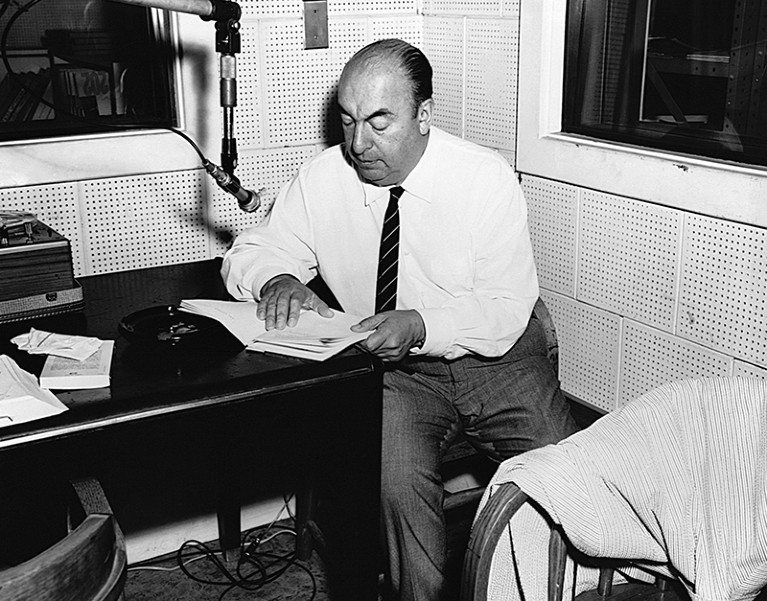
Pablo Neruda, who won the Nobel Prize in Literature in 1971, reads some of his poetry during a radio interview.Credit: Corbis via Getty
Scientists have concluded that renowned poet Pablo Neruda, a member of the Chilean communist party, might have had a toxic bacterium in his system when he died.
The finding is the latest in a decades-long investigation into the exact cause of Neruda’s death on 23 September 1973. Although the poet had advanced prostate cancer when he died, some have said that the timing of his passing — 12 days after general Augusto Pinochet overthrew the socialist government that Neruda supported — was no coincidence.
Can forensics establish whether Pablo Neruda was poisoned?
When announcing the new results on 13 February, Rodolfo Reyes, Neruda’s nephew and a lawyer representing his family, said they were proof that his uncle had been poisoned. Remnants of Clostridium botulinum, a bacterium that can produce the deadly botulinum toxin, were found in Neruda’s teeth, and they could have appeared there as the result of an injection, Reyes said. (Teeth have blood vessels in their roots, so pathogens circulating in a person’s blood when they die could theoretically be preserved there.) This method of poisoning “grants the appearance of a natural death”, Reyes told Nature.
Some of the researchers who helped with the investigation, however, say the evidence is far from conclusive. There is nothing in the science that proves he was poisoned, says Hendrik Poinar, a molecular geneticist at McMaster University in Hamilton, Canada. It’s neither a “closed door” nor a “smoking gun”, he adds.
A forensic search
In 2011, decades after Neruda’s passing, his former driver Manuel Araya alleged in an interview that Neruda had received an unscheduled injection a few hours before dying. Shortly afterwards, the Chilean communist party filed a complaint, saying that Neruda had been poisoned by Pinochet’s regime.
To get answers, a judge ordered the exhumation of Neruda’s remains and chose an international panel of specialists to analyse them. In 2013, that panel reported that it had screened the remains for some 2,000 chemical agents, such as arsenic, but did not find any evidence of poisoning.
‘I feel lost’: Chilean researchers saddened by vote to reject new constitution
Two years later, the judge organized a second panel to search for any evidence of biological poisons among the remains. That panel — made up of researchers from McMaster University, the University of Copenhagen in Denmark, and other institutions — found DNA fragments from Clostridium botulinum in Neruda’s teeth.
To determine whether the neurotoxin-producing bacterium was in Neruda’s body at the time of his death, or whether it was a contaminant that entered from the soil afterwards, the same laboratories continued the investigation. Their work culminated in the latest report, issued to a judge on 15 February. Because the judge has not released the results publicly, Nature spoke to some of the scientists who conducted the work.
They say they started by using a technique called shotgun metagenomic sequencing to study human and bacterial DNA extracted from Neruda’s bones and teeth. The researchers compared the degradation of the DNA from C. botulinum to the degradation of Neruda’s own DNA and that of other bacteria in his mouth. They found that the degradation patterns were similar, suggesting that C. botulinum could have been in Neruda’s body around the time he died.
“Technology has changed dramatically in the last few years. There was no way of doing [all] this seven years ago”, Poinar says.
Ruling out the possibilities
Still, the scientists caution against making any strong conclusions from their investigation so far.
“An injection is not the only possible explanation,” says Marie-Louise Kampmann, a forensic genticist at the University of Copenhagen who was part of the panel. For instance, “one alternative would be eating the bacteria in poisoned food”, because C. botulinum can grow in improperly canned foods, she says.
Chile’s science transformation gains steam with new president
Kampmann also acknowledges that comparing levels of DNA degradation cannot rule out that the bacterium entered the body after Neruda’s death. One DNA sample that has been in a warm, humid environment for only 10 years might have the same amount of degradation as one that’s been in a cold, dark setting for 50 years, she says, so comparisons can be deceiving.
Carles Lalueza Fox, an ancient-DNA researcher and director of Barcelona’s Natural Sciences Museum in Spain, who was not involved in the studies, agrees. “One cannot completely rule out that the bacteria penetrated in the teeth after death,” he says.
The scientists hope the judge will allow more research to be carried out. “We have worked with a heavily degraded and only partial genome,” Poinar says. The panel managed to piece together one-third of the bacterial DNA sequence extracted from Neruda’s teeth. In that sequence, the researchers identified a gene responsible for producing the botulinum toxin, although they did not find evidence of the toxin itself. “A follow-up is needed to be sure about the presence of [additional] toxic genes” because not all strains of C. botulinum produce the toxin, Poinar adds.
It is unclear whether the judge will order further investigations or use the findings to issue a ruling. No deadline has been set for a decision.




